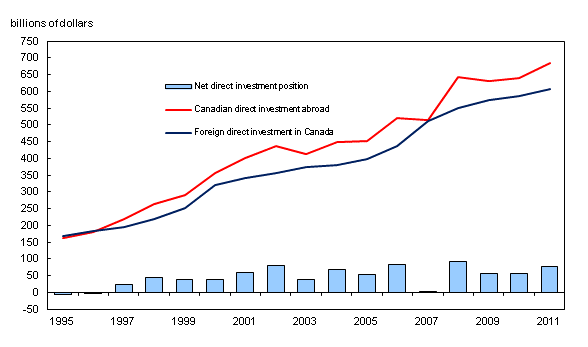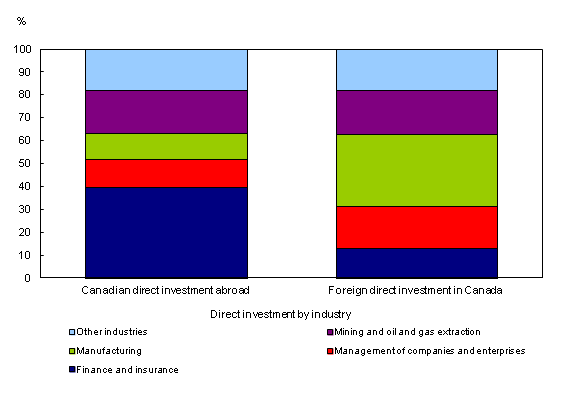Foreign direct investment, 2011
Archived Content
Information identified as archived is provided for reference, research or recordkeeping purposes. It is not subject to the Government of Canada Web Standards and has not been altered or updated since it was archived. Please "contact us" to request a format other than those available.
Related subjects
-
[an error occurred while processing this directive]
Canadian direct investment assets abroad increased 7.0% in 2011, mainly on growth in investment in the United States. This increase reflected large cross-border transactions in the year, as well as the upward revaluation effect of the depreciation of the Canadian dollar. The level of foreign direct investment in Canada (+3.8%) increased at a slower pace, led by investment from the United States and Europe.
Canadian direct investment abroad was up $44.6 billion by the end of 2011 to $684.5 billion. Foreign direct investment in Canada advanced $22.4 billion to $607.5 billion. As a result, Canada's net direct investment asset position expanded to $77.0 billion in 2011.
Foreign direct investment position

Chart description: Foreign direct investment position
Increase in Canadian direct investment abroad is focused in the United States
Canadian direct investment in the United States increased $22.7 billion to $276.1 billion. Canadian direct investment in all other countries was up $21.9 billion to $408.4 billion in 2011, with notable increases in Barbados, Australia and Bermuda.
The shares of total Canadian direct investment in the United States and the United Kingdom have been trending downward for a number of years. However, the United States' share edged up to 40.3% in 2011, as the United Kingdom's share edged down to 12.2%. The proportion of Canadian direct investment in the European region declined slightly over the previous two years to 26.6%.
Canadian direct investment in the Caribbean has been on an upward trend for most of the past 10 years. The largest increase in 2011 was in Barbados, which accounted for 7.8% of total Canadian direct investment abroad by year-end. The proportion of Canadian direct investment in the Asia and Oceania region has also risen, from 7.2% in 2001 to 9.7% by the end of 2011.
Foreign direct investment in Canada from the United States and Europe on the rise
Direct investment in the Canadian economy from Europe was up 5.7% to $184.2 billion in 2011, while that from the United States rose 2.4% to $326.1 billion. Nevertheless, the share of the United States' direct investment in Canada declined to 53.7% in 2011, resuming a downward trend that began in the early 2000s.
The Netherlands remained the second-largest direct investor in Canada in 2011, a position that it has maintained since 2008. The Netherlands accounted for 9.3% of total direct investment in Canada, followed by the United Kingdom (6.4%), Luxembourg (4.2%) and Switzerland (3.3%).
The share of direct investment in Canada from the Asia and Oceania region more than doubled from 4.5% in 2001 to 11.4% in 2011. One of the main contributors to this increase was China, with a year-end position of $10.9 billion in 2011 compared with $219 million 10 years earlier.
Canadian direct investment abroad concentrated in financial-management industries
In 2011, 51.7% of Canadian direct investment abroad was in the finance, insurance and management industries, compared with 38.1% in 2001. The mining and oil and gas extraction industry also saw an increased share of Canadian direct investment abroad, rising from 11.8% to 18.8% over the same 10-year period. At the same time, the share of investment in manufacturing abroad declined to 11.2% from 26.7%.
Canadian direct investment abroad and foreign direct investment in Canada, industry distribution, 2011

Foreign direct investment in Canada largely accounted for in manufacturing
Manufacturing remained the largest industry for foreign direct investment in Canada, accounting for 31.7% of these assets by the end of 2011; however, it was down from a high of 43.5% in 2000. The share of the mining, oil and gas extraction industry has risen from 13.6% in 2001 to 19.1% in 2011.
Note to readers
This is the annual release of detailed foreign direct investment data. This release contains country and industry details for direct investment that is drawn from the annual survey. This information is not available at the time of the quarterly International Investment Position release.
Direct investment is a component of the international investment position that refers to investment of a resident entity in one country obtaining a lasting interest in an enterprise resident in another country. The lasting interest implies the existence of a long-term relationship between the direct investor and the enterprise and a significant degree of influence by the investor on the management of the enterprise.
In practice, direct investment is deemed to occur when a company owns at least 10% of the voting equity in a foreign enterprise. This release presents the cumulative year-end positions for direct investment. In the Canadian statistics, direct investment is measured as the total value of equity, net long-term claims and net short-term claims held by the enterprise abroad.
Foreign direct investment is often channelled through intermediate holding companies or other legal entities before reaching its ultimate destination. Since these entities are generally in the financial sector, this sector accounts for a larger share on an immediate investor basis than if the ultimate destination were known. This is especially the case for Canadian direct investment abroad.
Currency valuation
The value of Canadian direct investment abroad is denominated in foreign currency and converted to Canadian dollars at the end of each period for which a year-end position is calculated. When the Canadian dollar is depreciating in value, the restatement of the value of direct investment abroad in Canadian dollars increases the recorded value. The opposite is true when the dollar is appreciating. Foreign direct investment in Canada is directly recorded in Canadian dollars and the fluctuation of the Canadian dollar has no impact on the recorded value.
In 2011, the Canadian dollar depreciated 2.2% against the US dollar, 1.8% against the British pound and 7.2% against the Japanese yen. It appreciated 1.0% against the euro.
Industry classification
The industry classification of foreign direct investment is based on the North American Industry Classification System (NAICS). At the time of this release, an updated version of NAICS was used for inward foreign direct investment (foreign direct investment in Canada) from 1999 onward. This change had no impact on the total value of foreign direct investment in Canada, but with the reclassification of some enterprises, the figures for certain industrial groups have changed.
Available without charge in CANSIM: tables CANSIM table376-0038 and CANSIM table376-0051 to 376-0054.
Definitions, data sources and methods: survey number survey number1537.
For more information, contact Statistics Canada's National Contact Centre (toll-free 1-800-263-1136; 613-951-8116; infostats@statcan.gc.ca).
To enquire about the concepts, methods or data quality of this release, contact Christian Lajule (613-951-2062; christian.lajule@statcan.gc.ca) or Marie-Josée Lamontagne (613-951-5179; marie-josee.lamontagne@statcan.gc.ca), Balance of Payments Division.
- Date modified:
